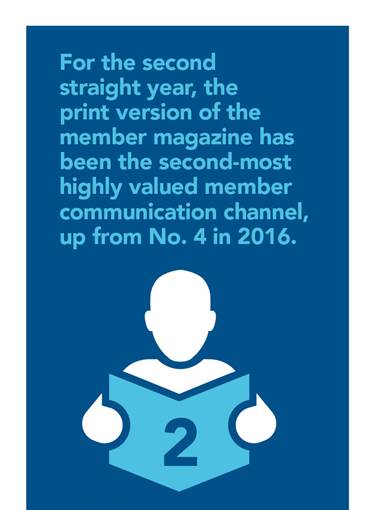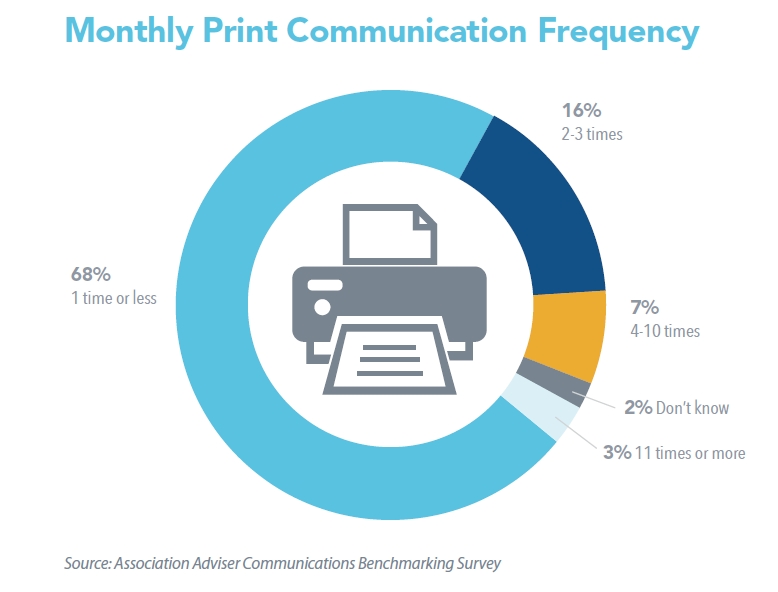Print is Alive and Kicking
“Wait…print isn’t dead? Not at all – recent surveys demonstrate that younger generations prefer print and read more than older generations.”
Forbes.com: Millennials: A Generation of Page-Turners, Jan. 16, 2017
 Forecasts a decade ago proclaiming print media would join the dinosaurs was vastly shortsighted. While print media’s role has evolved over time, it is not dead. According to Naylor’s 2018 Association Communications Benchmarking Survey, print magazines have been the second most-valued communication channel (behind conferences and networking events) for two years now. What does this mean for associations? If you want to reach your members with valuable industry information, you should consider the printed word.
Forecasts a decade ago proclaiming print media would join the dinosaurs was vastly shortsighted. While print media’s role has evolved over time, it is not dead. According to Naylor’s 2018 Association Communications Benchmarking Survey, print magazines have been the second most-valued communication channel (behind conferences and networking events) for two years now. What does this mean for associations? If you want to reach your members with valuable industry information, you should consider the printed word.
One in four associations communicates with members multiple times per month via print, according to the survey. And almost 70 percent of respondents reach out once per month through print communications. For the naysayers who warn that print is dead, please take note.
Roll the Presses
Magazines and other print media offer something digital content just can’t touch, literally. Print stands out in a digital world. One of the advantages of thumbing through pages is that there are no pop-ups or flashing ads distracting you from the subject matter. It’s a break from the clutter of online blogs, snippets, videos, etc. Print is also a laser-focused way to reach a targeted audience (YOUR MEMBERS) about specific issues (YOUR INDUSTRY).
The packaging and “eye candy” appeal is paramount when attracting readers. One association says the recent rebranding and redesign of their bimonthly magazine received lots of positive member feedback. “Providing our members with industry-related content as well as updating them with association events and educational opportunities in print form is a huge benefit for the Atlanta market,” says Ashley Calhoun, communications coordinator for Atlanta Apartment Association. “There is more flexibility in the content we can produce with print versus digital content. Having a print publication has helped build more awareness among our members,” she emphasized about AAA’s bimonthly magazine, Habitat.
Tangible Intel
A primary service associations deliver to members is industry information. Many times, association publications and announcements are a member’s only source to find out about recent legislation, new issues and pertinent events.
“The magazine is a very good complement to our efforts regarding legislation and policy issues,” says Schuyler Harding, communication manager for Association County Commissioners of Georgia. “We often use space in our magazine to expound on the big legislative issues that are extremely significant to county government officials and pertinent to county government operations.”
In addition to its prominence, print has a permanence digital does not. Because print is more physically permanent than digital communications, authors and publishers are more accountable for what they put in print, making printed communications a more trusted source in many readers’ eyes.
For the first time, printed member newsletters and show guides appeared in the Top 10 preferred communication channels in the Communications Benchmarking Survey. While digital content is searchable and quickly accessible, nothing replaces a printed show guide. We’ve all made those side notes in the margins of a printed guide. It’s much easier to pen a quick note on a page than access the note app on a device and painstakingly type something out using a tiny QWERTY keyboard or even worse, talking to text it out. And forget about making notes on those specially developed social apps for conferences.
Print media is more communally consumed than digital media, in a literal sense. Magazines and books can be found in libraries, coffee tables, desks and office lobbies. “Some universities catalog Georgia County Government magazine as reference material for students,” Harding says, stressing the importance of a physical presence.
What Now?
If your association is already publishing a magazine, it’s a good idea to occasionally revisit both the design/branding and the frequency of the publication. If you recently launched a new logo, branding campaign or association name change, it may make sense to entertain the idea of a redesign. If you have an abundance of content or advertising you can’t fit into a quarterly schedule, you may want to consider a bimonthly publication. The reverse is true as well.

Other printed member communications consists of white papers from conference sessions, repurposing digital content in a nicely packaged annual magazine, industry awards booklets, buyers’ guides – the list goes on.
While there are printing costs to consider, the value of print to your members could outweigh those costs. Print can still be a major revenue generator for associations. Just think – the digital newsletters or blogs your association has produced over the past year could become a real revenue-boosting, page turner as a printed annual special issue.
After all, there’s nothing like having an eye-catching cover of your association magazine sitting on the lobby waiting area table to encourage a prospective member, sponsor or your next president to peruse. Opportunities abound in print – and it’s one of the most effective ways to engage and educate members.
Top 3 Print Communication Channels:
- Member magazine
- Newsletter
- Show guide
Source: 2018 Association Adviser Communications Benchmarking Survey


